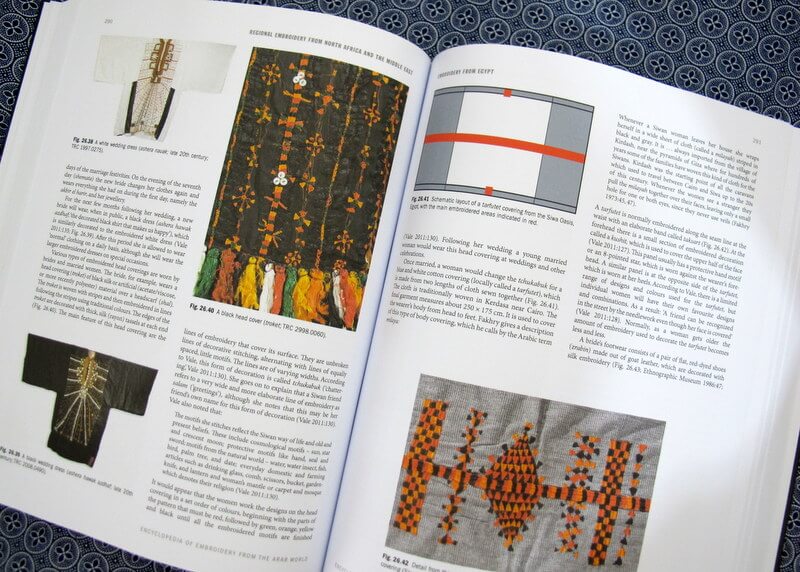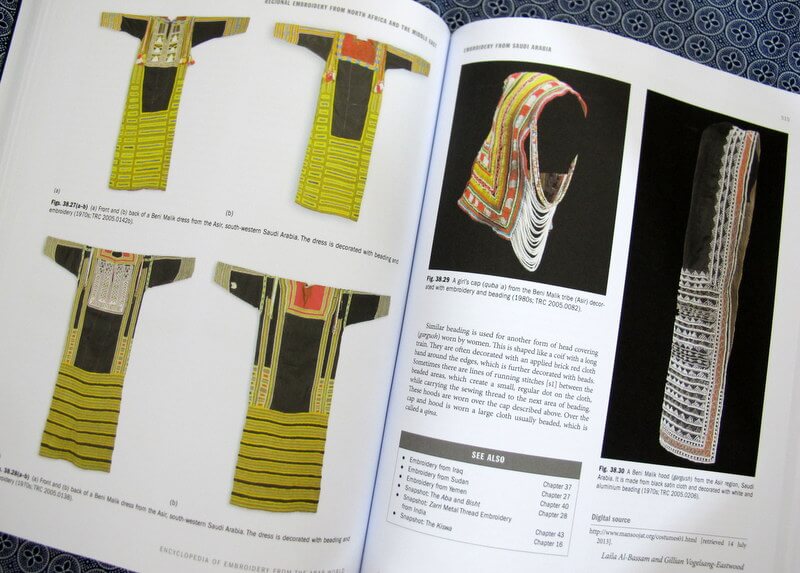Authors:
Gillian Vogelsang-Eastwood
Photographer: Various
Publisher: Bloomsbury
Format & Layout
214 x 279 x 48 mm (8.4" x 11" x 1.9”)
Hardcover
704 pages
ISBN 978-0857853974
Text and images on a white background
English

Photos, Illustrations & Diagrams
As with any good encyclopaedia, this book contains multiple photos, illustrations, maps and diagrams. Images are mostly in colour, but a few historical photos are in black and white. Most images are informational and technical showing textiles and garments either in full or partial details.
The textiles discussed here are all related to place and culture, making maps an essential tool for ‘putting them in their place’ and anchoring the text. This book contains several maps.
The author included many diagrams, stitch layouts and sketches to explain and analyse the embroideries from different regions. They are simple, clear, easy to read and a great addition to the book.

Introduction
This is an encyclopaedia in the full meaning of the word. It is a reference book, but instead of being academic and dry, it is rich, informative, accessible and readable.
As the author explains: “The original intention was to produce an academic study. However, it soon became clear that an in-depth study for a much wider audience was needed. It was decided to look at the concept of embroidery from various angles, including types, techniques, uses, regional styles, as well as historical, social and economic contexts. It places embroidery in the widest sense of the word, into the broader context of the general cultural life of North Africa and the Middle East, rather than being a ‘how-to’ book or a book about the social or economic role of embroidery in a specific period or associated with a particular group. Little did we know what the ‘simple’ decision would entail.”
Gillian Vogelsang-Eastwood is the director of the
Textile Research Centre in Leiden, the Netherlands. She is a textile archaeologist with many years of experience - both practical and academic - in the Arab region, working with textiles from these cultures. She is assisted by contributors
Widad Kawar, Layla Pio, Caroline Stone and others who are all specialists in their fields and powerhouses of knowledge and expertise in their respective culture’s textiles.
in 2017 this book won the international and prestigious award, the Dartmouth Medal (American Library Association), which put the academic study of Arab textiles and more specifically embroidery on the academic map.
This is not lightweight reading. But neither is it only a textbook nor a highbrow academic work. This book is relatable, practical, easy to read and packed with information.

Content
The
Encyclopedia of Embroidery from the Arab World is divided into four sections.
- Background information. Setting the scene, this section gives a brief introduction to the people, their influences, the materials and equipment, techniques and their use of colour and design.
- Embroideries from Archaeological and Historical sources: This section look at textile discoveries and artefacts coming from Egyptian tombs, Mesopotamia, the Levant, the Byzantine empire, the Ottoman era, and other ancient civilisations in this region.
- Regional embroidery from North Africa and the Middle East. This section makes up the bulk of the book and contains 27 chapters looking at historical and modern embroidery from different regions and cultures within the wider Arab world.
- The last section contains appendices (including comprehensive stitch diagrams), bibliographies, glossaries, and an index.
Each chapter is richly illustrated with photos, diagrams, illustrations and maps. The text is written in easy to read language and divided into short chapters with subheadings. The text is laid out on the page in two columns.
At the end of each chapter, there is a list of suggested follow up reading. The author makes it clear that the book is not meant to be read linearly. It is meant to be browsed. The reader is encouraged to jump around between chapters, following different threads of interest, whether it is an era, a culture, stitch types, or historical timelines.

Conclusion
The
Encyclopedia of Embroidery from the Arab World has a physical presence. It is a heavy book of almost biblical proportions. Just by holding it, the reader can feel the impact of this book.
Yet, it is a very accessible book. It is well laid out, easy to navigate, and easy to read. It is filled with facts, but these facts are presented in a personal and understandable way. The author’s obvious interest and delight in the subject matter, her genuine interest in, not only embroidery but in sharing her knowledge and love of the subject with the reader is palpable. It has a lightness about it – like a thread.
The book is colourful and visually pleasing. The word encyclopedia conjures images of a book that is drab and boring, with poor quality black and white images. It is not true of this book. The images are bright, good quality and very informative.
Encyclopedia of Embroidery from the Arab World is reminiscent of a finely embroidered
tapestry
Tapestry: wall hanging or other large piece of fabric that is woven in coloured weft
Weft: one of the two basic components used in weaving that transforms thread or yarns into a piece of fabric. It is the crosswise thread on a loom that is passed over and under the warp threads. threads or embroidered with a decorative design. Typically made of wool, but they can also be made of other materials such as silk, linen, or cotton. Often used to decorate homes, churches, and other buildings. . Made up of different strands of fine fibre, each meticulously spun, coloured and threaded. Each one is from a different place, representing a different story. Woven together, worked one on top of the other in intricate stitches, they create a
tapestry
Tapestry: wall hanging or other large piece of fabric that is woven in coloured weft
Weft: one of the two basic components used in weaving that transforms thread or yarns into a piece of fabric. It is the crosswise thread on a loom that is passed over and under the warp threads. threads or embroidered with a decorative design. Typically made of wool, but they can also be made of other materials such as silk, linen, or cotton. Often used to decorate homes, churches, and other buildings. , a stitched story. The finished product is heavy. Heavy from the sheer weight of the fibre, but also heavy with history, with culture, with effort and love.
This is not just a book. It is a legacy.
Get your copy
here.








